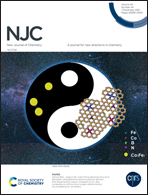Bimetallic conjugated microporous polymer derived B,N-doped porous carbon wrapped Co3Fe7 alloy composite as a bifunctional oxygen electrocatalyst for a breathing Zn–air battery†
Abstract
The exploration and development of high-performance, durable and economic bifunctional electrocatalysts towards the oxygen reduction reaction (ORR) and the oxygen evolution reaction (OER) is essential but challenging for the development of rechargeable Zn–air batteries (ZABs). Metal coordinated conjugated microporous polymers (CMPs) with an inherent rigid structure and customizable elemental composition are regarded as ideal precursors for the target preparation of porous carbon-based catalysts. Whereas it is hard to obtain bifunctional catalysts from monometallic CMPs. Here, we report a bimetallic conjugated microporous polymer (CMP) composed of boron dipyrromethene (bodipy) and Fe/Co-porphyrin (BP-CMP). Direct pyrolysis of the BP-CMP yields a defect-enriched B,N-codoped carbon composite, denoted as BP-800, with embedded Co3Fe7 and Fe/Co–N sites. The high specific surface area (890 m2 g−1) and hierarchical pore structure provide easily accessible active sites, significantly enhancing the oxygen catalytic activity. Meanwhile, the additional doping of B imparts a synergistic effect to the catalyst, which could not only realize the fine adjustment of the electronic properties, but also of the surface polarities of the carbon matrix. Therefore, compared with the B-free catalyst (P-800), BP-800 presents outstanding bifunctional catalytic activity for electrochemical oxygen reactions. For example, it presents superior catalytic performance with a super long-term running stability and fuel immunity, as well as a favored 4e-reduction pathway for the reduction of oxygen (ORR) in the whole pH range. Furthermore, compared with a commercial Pt/C catalyzed battery, the homemade ZABs using BP-800 as the cathode catalyst presented a higher open-circuit voltage (1.526 V), power density (185 mW cm−2), discharge specific capacity (776 mA h gZn−1 at 10 mA cm−2) and a longer cycle life (94 h at 10 mA cm−2), as well as excellent rate capacity. Moreover, owing to the effective protection of porous carbon in the alloy nanoparticles, the rechargeable ZAB with the BP-800 catalyst delivers excellent stability during long-term charging–discharging cycles, comparable to that of the commercial Pt/C and IrO2 benchmarks. This work paves an avenue for the synthesis of stable and efficient electrocatalysts to drive the development of breathing Zn–air batteries.



 Please wait while we load your content...
Please wait while we load your content...